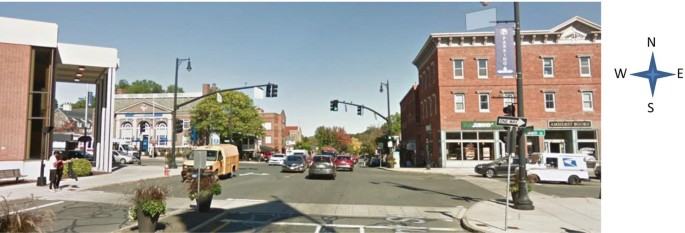Abstract
Phase is a period of time during which one or more movements receive right-of-way, and the act of determining which phases to use and which movements to include is called phasing. Closely related to phasing are sequencing which is the act of arranging the order of phases for safety and efficiency purposes and timing which is the act of determining the length and splits of each phase. Phasing is the focus of this chapter, and sequencing will be discussed in the next chapter since it depends on how left-turn movements are treated. Once phasing and sequencing are determined, timing of each phase can be calculated which will be the topic of the chapter that follows. Collectively, phasing, sequencing, and timing constitute the development of a timing plan for a signalized intersection.
Access this chapter
Tax calculation will be finalised at checkout
Purchases are for personal use only
Notes
- 1.
Section 1A.13.206 of 2009 MUTCD with Revisions 1 and 2, May 2012.
Author information
Authors and Affiliations
End-of-Chapter Problems
End-of-Chapter Problems
-
1.
The figure below shows the intersection of North Pleasant and Main Street in downtown Amherst, MA that features a heavy pedestrian volume. In response, the intersection runs three phases. In one phase, all north–south movements are served. Another phase allows all east–west movements. In the third phase, all vehicular movements are stopped permitting pedestrians in all directions. Draw a movement diagram and a ring and barrier diagram to represent signal operation at this intersection.

-
2.
Elaborate what actually causes the Yellow Trap problem and provide one way to resolve the problem.
-
3.
The figure below shows the intersection of South East Street (north–south direction) and College Street (east–west direction) with the photo taken facing north. The intersection operates an eight-phase signal control, and the heaviest volume is carried by the eastbound approach in the afternoon peak hour. (1) Try to name the eight phases using NEMA phase naming convention, and (2) Draw a ring and barrier diagram with the east–west direction starting with a dual left-turn phase and the north–south direction with a leading (southbound) and lagging (northbound) configuration.

Rights and permissions
Copyright information
© 2020 Springer Nature Switzerland AG
About this chapter
Cite this chapter
Ni, D. (2020). Signal Phasing. In: Signalized Intersections. Springer, Cham. https://doi.org/10.1007/978-3-030-38549-1_3
Download citation
DOI: https://doi.org/10.1007/978-3-030-38549-1_3
Published:
Publisher Name: Springer, Cham
Print ISBN: 978-3-030-38548-4
Online ISBN: 978-3-030-38549-1
eBook Packages: EngineeringEngineering (R0)



